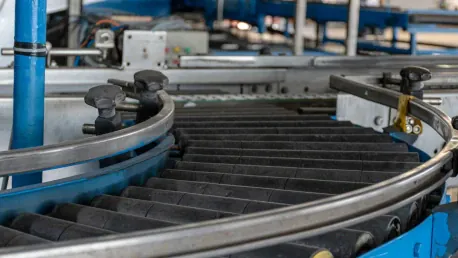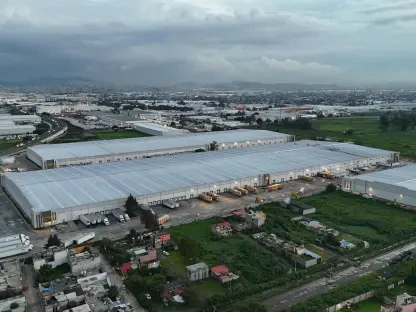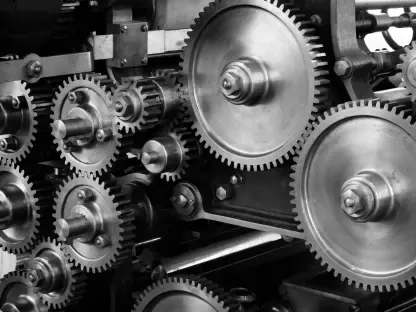The US manufacturing sector is showing signs of a potential positive shift after a two-year global slump. This development is noteworthy because the manufacturing sector has seen a downturn, making signs of revival significant not only for the economy but also for investor sentiment. The manufacturing sector, although smaller than the services sector, holds substantial symbolic value and affects economic perceptions more noticeably.
The Role of Manufacturing in the US Economy
Symbolic Importance of Manufacturing
Manufacturing accounts for 17.1% of the US GDP, while the services sector dominates with 71.7%. Despite its smaller role, manufacturing has significant symbolic value. The tangible nature of manufactured goods makes improvements in this sector visible and influential, affecting investor sentiment and economic perceptions more noticeably than services. For instance, when consumers see factories operating at full capacity or new products rolling off assembly lines, it creates a palpable sense of economic health and vitality. This visibility extends beyond domestic borders, influencing international investors’ perspectives on the US economy.
The symbolic importance of manufacturing also corresponds to job creation and community development. Manufacturing jobs are often seen as stable and well-paying, contributing to the economic security of communities across the country. This stability is especially crucial in regions heavily reliant on manufacturing, where factory closures or downsizing can have disproportionate economic and social impacts. Therefore, any positive shifts in this sector not only boost investor confidence but also enhance the general economic well-being of numerous communities.
Economic Impact of Manufacturing
The manufacturing sector’s resurgence could bolster sentiment and optimism. Positive sentiment plays a key role in driving investment returns, particularly as bull markets grow and mature. This is particularly crucial as the ISM Services PMI, while still showing growth at 52.8, has slowed slightly from 54.0 in December. Strengthening in manufacturing could counterbalance the slight slowdown in services and provide a holistic boost to the economy. As confidence in the manufacturing sector grows, it is likely to spur investments in other related sectors, amplifying the overall economic impact.
A robust manufacturing sector can also enhance productivity and innovation. Manufacturing often involves significant R&D expenditures, leading to technological advancements and efficiencies that benefit the broader economy. For example, improvements in manufacturing processes can lead to better quality products at lower costs, which can increase consumer spending and drive economic growth. Moreover, a revitalized manufacturing sector might encourage higher educational and vocational training investments, ensuring a skilled workforce ready to meet future industry demands.
Evidence of Recovery
Purchasing Managers’ Indexes (PMIs)
The primary evidence of a recovery is found in the purchasing managers’ indexes (PMIs) from the Institute for Supply Management (ISM). PMIs provide expedient snapshots of economic activity month-to-month. Specifically, a PMI reading above 50 indicates expansion, while below 50 indicates contraction. For January, the ISM’s Manufacturing PMI rose to 50.9, marking the first expansion since October 2022. This progress is further supported by the New Orders component, which increased to 55.1, suggesting a continued positive trend. These numbers indicate not only an immediate improvement but a potential for sustained growth in the near future.
The PMI data also reveal underlying strengths in various manufacturing sub-sectors. For instance, industries such as automotive, electronics, and machinery have shown particular resilience, often leading the charge in recovery phases. The rise in New Orders points to increasing business confidence, as firms anticipate higher demand and ramp up production accordingly. This momentum can create a ripple effect, leading to higher employment rates, increased capital investment, and stronger economic growth. The PMI figures are thus a vital barometer, reflecting the health and future trajectory of the manufacturing industry.
Core Capital Goods Orders
Core capital goods orders—excluding defense and volatile aircraft—rose in five of the last seven months of 2024. This increase indicates a growing demand for business equipment and an optimistic outlook on future consumer demand. The manufacturing component of the monthly industrial production report showed growth of 0.5% in November and 0.6% in December. These gains also included significant contributions from durable goods, a sector that has traditionally been a weak spot. The positive performance in these areas signals a more robust industrial base, ready to meet future challenges and demands.
The increase in core capital goods orders suggests that businesses are gearing up for longer-term growth, investing in tools and machinery that will enhance their productive capacities. This trend often precedes periods of economic expansion, as companies seek to modernize their operations and improve efficiency. Moreover, the growth in durable goods, such as appliances and vehicles, reflects consumer confidence and willingness to make significant purchases. These indicators collectively paint a promising picture of a manufacturing sector on the verge of more sustained recovery and growth.
Supporting Trends
Increase in Imports
Imports, which often include components and resources for American manufacturing, also increased late last year. This suggests that businesses are anticipating increased production needs, potentially driven by the demand for restocking inventories and an overall upbeat consumer spending trend on goods. The rise in imports could be attributed to a combination of factors, including improved supply chain logistics and a more reliable flow of raw materials. As businesses plan for heightened production levels, the influx of imported components plays a critical role in ensuring seamless operations and timely product deliveries.
Furthermore, the increase in imports aligns with broader economic trends indicating robust consumer demand. As consumers continue to spend on goods, manufacturers are compelled to replenish their stocks, driving both domestic production and the import of essential components. This symbiotic relationship between imports and domestic manufacturing underscores the interconnected nature of the global supply chain. A sustained increase in imports, therefore, bodes well for future manufacturing output, suggesting that businesses are confident about maintaining higher production levels to meet continuous consumer demand.
Broader Economic Implications
An easing in manufacturing sector worries could improve the perception of broader economic health. This, in turn, might positively affect The Conference Board’s Leading Economic Index (LEI), which has been signaling a potential recession since early 2022 due to the manufacturing downturn. If the LEI begins to reflect improved manufacturing activity, it could alleviate investor concerns and stabilize market performance. A healthier manufacturing sector could also lead to increased business investments, higher employment rates, and stronger consumer spending, all contributing to a more resilient economy.
The broader economic implications extend to fiscal and monetary policy considerations. As manufacturing shows signs of recovery, policymakers may gain more confidence in the strength of the economy, potentially influencing decisions on interest rates and government spending. A stronger manufacturing sector can also provide a buffer against economic shocks, creating a more stable environment for growth. Additionally, improvements in manufacturing can lead to enhanced international competitiveness, boosting exports and further strengthening the overall economy. The cascading effects of a recovering manufacturing sector thus hold the potential to spur comprehensive economic growth and stability.
Cautious Optimism
Importance of Consistent Data
While the resurgence in manufacturing is a positive signal, it is essential to recognize that economic trends are clearer in hindsight. One-off data points do not confirm long-term trends; consistent data over time are necessary for more definitive conclusions. For instance, the recent upticks in PMI and capital goods orders are encouraging, but they need to be sustained over several quarters to confirm a genuine recovery. Additionally, some import increases might reflect businesses’ efforts to anticipate and adapt to tariff changes rather than a straightforward production uptick.
Consistent data over time can help policymakers and investors make informed decisions. For example, sustained improvements in manufacturing indices can justify further investments in infrastructure and workforce development. Conversely, if the positive data points prove to be anomalies, businesses and government agencies can adjust their strategies accordingly. This cautious optimism is rooted in a comprehensive analysis of ongoing trends, ensuring that any conclusions drawn are based on robust and reliable data. Thus, consistent and multi-faceted data remain crucial in painting an accurate picture of the manufacturing sector’s health and future prospects.
Psychological and Sentiment-Based Effects
The psychological and sentiment-based effects of a manufacturing recovery could be significant. Manufacturing difficulties have contributed to a “wall of worry” for US stocks, creating a general sense of economic uncertainty. Reduced fears in this arena are inherently bullish, potentially aiding in further economic stabilization and growth. As investor confidence grows, it can lead to increased inflows of capital into the stock market, driving up asset prices and fostering a more optimistic economic outlook. This positive feedback loop can further consolidate manufacturing gains, creating a cycle of sustained growth.
Moreover, the psychological impact extends beyond investor sentiment to consumer behavior. When consumers perceive the economy as robust, they are more likely to make significant purchases, such as automobiles or home appliances, which in turn boosts manufacturing output. This interplay of sentiment and economic activity highlights the intangible yet powerful role of psychological factors in driving economic trends. As manufacturing continues to show signs of recovery, it can generate a sense of confidence and stability that permeates various sectors of the economy, fostering an environment conducive to sustained growth and prosperity.
Global Implications
Potential Global Economic Improvements
If the positive shift in US manufacturing is sustained and mirroring developments occur globally, especially in Europe with its greater reliance on manufacturing, it could herald more significant global economic improvements. Positive momentum in US manufacturing can serve as a catalyst for other major economies, encouraging a synchronized global recovery. This international interdependence means that robust manufacturing activity in one region can have far-reaching effects, stimulating trade and investment across borders. A revitalized manufacturing sector in the US could thus play a crucial role in driving worldwide economic stability and growth.
Global economic improvements would also see enhanced collaboration and coordination among international trade partners. As manufacturing activity picks up, supply chain efficiencies and innovations can be shared globally, creating a more integrated and resilient international market. Increased global demand for goods could lead to higher production levels, fostering employment and economic opportunities in both developed and developing nations. Therefore, the ripple effects of the US manufacturing recovery highlight the interconnected nature of global economic health and the potential for widespread, mutually beneficial growth.
Interconnected Economic Sectors
The US manufacturing sector appears to be on the brink of a positive turnaround following a two-year worldwide slump. This situation is important, given that the sector has experienced significant setbacks recently. Indications of a revival hold considerable weight, not just for the overall economy, but also in terms of investor confidence. The manufacturing sector, while smaller when compared to the services sector, carries substantial symbolic importance. Its performance can shift public and economic perceptions more markedly than the more dominant services sector.
Positive signals within manufacturing can boost optimism, influencing other sectors and cascading through investment and consumer confidence. This renewed vigor could have far-reaching implications beyond mere production numbers. It reflects resilience and adaptability in the face of global challenges. In short, the recovery of the manufacturing sector plays a pivotal role in shaping broader economic trends and maintaining a balanced view of the country’s economic health.









